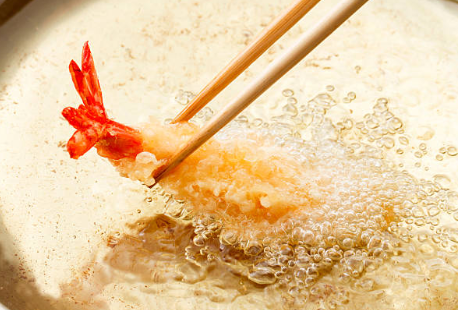
The Art of Perfect Frying
Frying food to perfection is an art that requires skill and precision. From crispy vegetables to succulent seafood, mastering the art of frying can elevate your culinary creations to new heights. In this article, we will explore the essential techniques and tools for achieving the perfect fry, along with expert tips for maintaining the ideal oil temperature.
Mastering the Frying Techniques
Eggplant Frying Start by thoroughly washing the eggplant and cutting it into 4-5cm lengths. Make shallow cuts with a knife, coat them with flour, and fry until golden brown.
Perilla Leaf Frying Remove excess moisture from each perilla leaf, lightly coat with flour, and fry until the batter is just cooked.
Shrimp Frying For perfectly fried shrimp, leave the tail intact, remove the shell and head, and make shallow cuts along the back to prevent curling. Once the oil reaches 180-190°C, coat the shrimp with flour and fry until golden brown.
Perfecting the Oil Temperature
Determining the ideal oil temperature is crucial for achieving a crispy, golden exterior while ensuring that the interior is perfectly cooked. Here are some methods for gauging the oil temperature:
Using Chopsticks Insert a chopstick into the oil to gauge the temperature:
- A few bubbles form at the tip of the chopstick (approximately 150°C)
- Small bubbles rise from the entire surface of the chopstick (approximately 160-170°C)
- Many bubbles form around the chopstick (approximately 180°C)
Dropping Batter Drop a small amount of batter into the oil to assess the temperature:
- The batter sinks to the bottom and slowly rises (150°C or below)
- It initially sinks, then gradually rises (150-160°C)
- It sinks halfway, then quickly rises (170-180°C)
- The batter disperses on the oil surface (180°C or above)
Crafting the Perfect Batter
Creating a light and crispy batter is essential for achieving the perfect fry. Here's how to make the ideal batter for your fried dishes:
Using a Deep-Frying Pot Select a pot with a thickness of 3-4mm, a depth of 8-10cm, and a diameter of 26cm or larger. Cast iron and enameled pots are convenient for maintaining heat.
Wooden Chopsticks Opt for lightweight and sturdy wooden chopsticks that are approximately 30cm for frying and grilling, and around 20cm for other cooking methods. Clean them with kitchen detergent and thoroughly dry. To prevent charring, trim the tips with a knife or sandpaper if they are frequently used for hot frying or grilling.
Oil Draining Container Choose a stainless steel or enameled container that is easy to clean and comes with a well-fitting lid. After heating, clean stainless steel products with a cleaner, while enameled ones should be washed with dishwashing detergent and completely dried.
Essential Tools for Perfect Frying
Frying Pot A pot with a thickness of 3-4mm, a depth of 8-10cm, and a diameter of 26cm or larger is ideal. Cast iron and enameled pots are convenient for maintaining heat.
Wooden Chopsticks Lightweight, sturdy, and non-slip wooden chopsticks are suitable for frying and grilling. Approximately 30cm in length for frying and grilling, and around 20cm for other cooking methods.
Oil Draining Container Opt for a stainless steel or enameled container that is easy to clean and comes with a well-fitting lid. After heating, clean stainless steel products with a cleaner, while enameled ones should be washed with dishwashing detergent and completely dried.
By mastering the art of frying and selecting the right tools, you can elevate your culinary skills and create delectable fried dishes that will impress even the most discerning palates.
'실생활 정보 세상의 정보' 카테고리의 다른 글
| Did they not carry out the death penalty on rainy days from the beginning (0) | 2024.01.18 |
|---|---|
| Wear a parka and know it (0) | 2024.01.18 |
| The use and examples of the back court (0) | 2024.01.17 |
| The history of HACCP (0) | 2024.01.16 |
| Principle of proportionality in administrative law (0) | 2024.01.15 |



